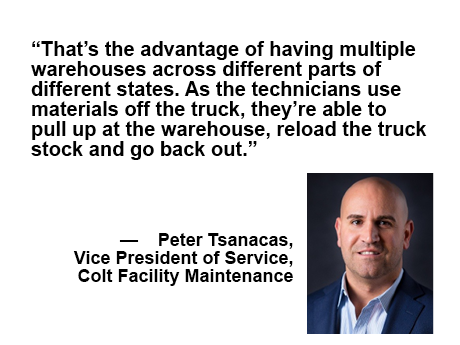Running a retail or restaurant facility requires balancing costs, maintenance and operational uptime — a challenge that is further compounded when dealing with multiple stores. Facility owners and operators face the challenge of keeping their properties in top condition while managing expenses and minimizing disruptions to business.
In the retail and restaurant industries, any downtime at all can be costly. A malfunctioning bathroom or a broken HVAC system can lead to customer dissatisfaction, lost revenue and temporary closures.
Preventative maintenance and proactive scheduling can address these concerns by managing costs, staggering renovation needs and reducing downtime. A skilled facility maintenance partner can offer strategies and even turn the challenges of multiple stores into a source of cost solutions.
Cost Challenges: Balancing Quality and Budget
One of the primary concerns for facility managers is controlling costs without sacrificing the quality of maintenance services. Many operators are tempted to cut corners by opting for the cheapest available service providers. However, this approach can lead to higher long-term expenses due to repeated repairs and subpar workmanship.
Choosing a self-performing maintenance contractor can be a more cost-effective solution. Unlike companies that rely on subcontractors, self-performing contractors employ their own technicians who are directly accountable for their work. This model not only ensures consistency in service quality but also provides greater control over costs. For example, Colt Facility Maintenance tailors its services to the specific needs of each job by assigning appropriately skilled technicians — who save on timelines and costs by doing the job correctly — and right away.
“Through the relationships we’ve built over the years with our many different customers, they know we’re fixing the problem the first time,” says Peter Tsanacas, vice president of service for Colt. “We have very low recalls, if any.”
Multiple-Facility Savings
Tsanacas and his team are aware of the company standards, materials and locations for their customers with multiple stores. Technicians are prepared and trucks are stocked with the correct supplies ahead of time when they are called to a work site.
“If we know a customer has the same store across multiple states, then we aren’t going in blind. We never want to leave a job site and then come back,” he says. “We know our customers well enough — and if our customers use a similar product across their portfolio — we’re able to stock the materials that they need on the truck. The first time we show up, we can get it done.”
An in-person, personalized approach enables Colt to offer volume pricing agreements with significant cost savings. Facilities with multiple locations can leverage their scale to negotiate better rates. The more locations a company manages, the more favorable the pricing structure is, allowing for a reduction in per-visit costs.
Scheduling and Timing
Since time is money, Colt leverages technology to provide tighter scheduling for their customers. One example is the use of GPS tracking of all technician vehicles.
“We can see in real time exactly where any of our technicians are at any given moment,” Tsanacas says. “If a customer has an emergency — for example, a restaurant with a bathroom that is out of service — we know they’re going to need that bathroom up and running as quickly as possible. Our GPS tracking helps us to determine where the nearest, appropriate technician is for faster service.”
Colt’s in-house work order management system allows technicians to have instructions, locations and details sent directly to their phones. Multiple warehouses keep their technicians moving.
“That’s the advantage of having multiple warehouses across different parts of different states,” Tsanacas says. “As the technicians use materials off the truck, they’re able to pull up at the warehouse, reload the truck stock and go back out.”
Preventative Maintenance: A Proactive Approach
Preventative maintenance is another critical strategy for managing costs and minimizing downtime. By addressing potential issues before they escalate, facility managers can avoid expensive emergency repairs and extend the lifespan of their equipment.
Regular maintenance tasks like plumbing line cleaning or HVAC system checks can prevent major failures that would otherwise lead to costly repairs and significant operational disruptions. Facilities that implement a robust preventative maintenance program can also benefit from lower costs by upgrading to more efficient systems. For example, customers switching from fluorescent to LED lighting can save electricity, while those installing water softening systems lessen the amount of cleanings needed for water lines.
Colt offers customized preventative maintenance programs designed to meet the specific needs of retail and restaurant facilities. These programs not only help keep properties in good working order but also contribute to long-term cost savings by reducing the frequency and severity of repairs. Any necessary fixes can be timed to minimize disruption within the business.
Disaster Response: Being Prepared for the Unexpected
Facility managers must also be prepared for unexpected events, including natural disasters, which can cause significant damage and disrupt operations. A proactive disaster response plan can mitigate the impact of such events.
Colt’s disaster response team exemplifies how a well-coordinated approach can help facilities recover quickly from hurricanes and other emergencies. By providing both pre-disaster preparations, like sandbagging and boarding up windows, and post-disaster services, such as water extraction and generator delivery, they help facilities resume operations with minimal delay.
Strategic Maintenance for Long-Term Success
For retail and restaurant facility owners and operators, managing costs, maintaining facilities and minimizing downtime are critical to long-term success. By partnering with a reliable, self-performing maintenance contractor and investing in preventative maintenance, facilities can achieve a balance between cost-effectiveness and operational excellence.
Implementing these strategies can lead to substantial cost savings, improved customer satisfaction and, ultimately, a more resilient and successful business.
— Colt Facility Maintenance is a content partner of Retail & Restaurant Facility Business. For more articles from and news about Colt Facility Maintenance, click here.
